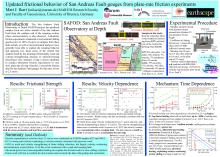Updated frictional behavior of San Andreas Fault gouges from plate-rate friction experiments
Matt IkariSubmitted September 11, 2022, SCEC Contribution #12249, 2022 SCEC Annual Meeting Poster #254 (PDF)
The San Andreas Fault is known for its large central creeping section separating locked, large earthquake-producing segments at its northern and southern ends. The San Andreas Fault Observatory at Depth (SAFOD) project has produced samples from two active strands of the San Andreas Fault from the southern end of the creeping section, where microseismicity is also observed. Laboratory friction experiments conducted at conventional sliding speeds (µm/s to 100’s of µm/s) on samples from these fault strands, as well as microstructural analyses, have generally been able to explain the creeping behavior and apparent low shear stress of the central San Andreas Fault by the shearing of frictionally weak and velocity-strengthening smectite or smectite-bearing mixed-layer clay minerals.
Using a recent capability to conduct laboratory friction experiments at very slow, plate-rate driving velocities, I extend the friction data for San Andreas Fault gouges for slip rates as low as 2.5 cm/yr. Preliminary data show that a sample of the serpentine block from the Southwest Deforming Zone (G27) shows Byerlee friction values and velocity weakening at low driving velocities with a tendency for approximately velocity-neutral friction at higher rates, broadly consistent with previous work. A sample of the smectite-rich fault core from the Central Deforming Zone (G43) shows a friction coefficient of near 0.4 at the plate-rate of 2.5 cm/yr, as well as large velocity-weakening at slow driving velocities. These observations contrast with previous friction experiments at conventional sliding velocities and geophysical observations, but can be explained by a previously observed time-dependent mechanism where frictional healing and thus fault locking potential become large at long timescales, thus becoming important at very slow sliding velocities. These new results may re-open a discussion on the geomechanics and earthquake potential of the central San Andreas Fault.
Key Words
San Andreas Fault, SAFOD, friction, velocity weakening
Citation
Ikari, M. (2022, 09). Updated frictional behavior of San Andreas Fault gouges from plate-rate friction experiments. Poster Presentation at 2022 SCEC Annual Meeting.
Related Projects & Working Groups
San Andreas Fault System (SAFS)




